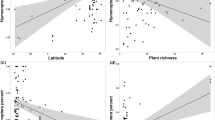Abstract
Floral visitors vary in their pollination efficiency and their preferences for floral traits. If low-efficiency pollinators decrease the amount of pollen available to higher efficiency visitors, then low-efficiency visitors may actually have negative fitness consequences for the plants that they visit. We used experimental arrays in two populations to determine the floral preferences and the fitness effects of low-efficiency (or “ugly”) pollinators on Campanula americana. These ugly pollinators (halictid bees) preferentially visited flowers with pollen over flowers that had had their pollen removed. C. americana pollen color varies quantitatively from light tan to dark purple, and we found that natural variation in pollen color influenced the magnitude of halictid preferences for flowers with pollen. In general, preferences for flowers with pollen were stronger when the ugly pollinators foraged in arrays of flowers with tan-colored pollen than in arrays with purple-colored pollen. When plants received few visits by efficient Bombus pollinators, visits by ugly pollinators significantly decreased siring success relative to plants where visits by ugly pollinators were prevented. In contrast, ugly pollinators did not influence siring success when higher efficiency pollinators were more abundant. Thus, the relationship between low-efficiency pollinators and the plants that they visit varies from commensalistic to antagonistic depending on the presence of other pollinators in the community. Our findings suggest that the negative fitness effects and floral preferences of low-efficiency or “ugly” pollinators may contribute to the maintenance of a pollen color polymorphism in C. americana.




Similar content being viewed by others
References
Ågren J, Elmqvist T, Tunlid A (1986) Pollination by deceit, floral sex ratios and seed set in dioecious Rubus chamaemorus. Oecologia 70:332–338
Ashman TL (2000) Pollinator selectivity and its implication for the evolution of dioecy and sexual dimorphism. Ecology 81:2577–2591
Ashman TL, Stanton M (1991) Seasonal variation in pollination dynamics of sexually dimorphic Sidalcea oregana ssp. spicata (Malvaceae). Ecology 72:993–1003
Bawa KS (1977) The reproductive biology of Cupania guatemalensis Radlk. (Sapindaceae). Evolution 31:52–63
Bell G, Lefebvre L, Giraldeau LA, Weary D (1984) Partial preference of insects for the male flowers of an annual herb. Oecologia 64:287–294
Bierzychudek P (1987) Pollinators increase the cost of sex by avoiding female flowers. Ecology 68:444–447
Charlesworth D (1993) Why are unisexual flowers associated with wind pollination and unspecialized pollinators? Am Nat 141:481–490
Cresswell JE, Robertson AW (1994) Discrimination by pollen-collecting bumblebees among differentially rewarding flowers of an alpine wildflower, Campanula rotundifolia (Campanulaceae). Oikos 69:304–308
Delph LF, Lively CM (1992) Pollinator visitation, floral display, and nectar production of the sexual morphs of a gynodioecious shrub. Oikos 63:161–170
Eckhart VM (1991) The effects of floral display on pollinator visitation vary among populations of Phacelia linearis (Hydrophyllaceae). Evol Ecol 5:370–384
Eckhart VM (1992) Spatio-temporal variation in abundance and variation in foraging behavior of the pollinators of gynodioecious Phacelia linearis (Hydrophyllaceae). Oikos 64:573–586
Evanhoe L, Galloway LF (2002) Floral longevity in Campanula americana (Campanulaceae): a comparison of morphological and functional gender phases. Am J Bot 89:587–591
Fenster CB, Dudash MR (2001) Spatiotemporal variation in the role of hummingbirds as pollinators of Silene virginica. Ecology 82:844–851
Fishbein M, Venable DL (1996) Diversity and temporal change in the effective pollinators of Asclepias tuberosa. Ecology 77:1061–1073
Galen C (1996) Rates of floral evolution: adaptation to bumblebee pollination in an alpine wildflower, Polemonium viscosum. Evolution 50:120–125
Inoue K, Maki M, Masuda M (1995) Different responses of pollinating bees to size variation and sexual phases in flowers of Campanula. Ecol Res 10:267–273
Inouye DW (1980) The terminology of floral larceny. Ecology 61:1251–1253
Inouye DW, Gill DE, Dudash MR, Fenster CB (1994) A model and lexicon for pollen fate. Am J Bot 81:1517–1530
Johnson SG, Delph LF, Elderkin CL (1995) The effect of petal-size manipulation on pollen removal, seed set, and insect-visitor behavior in Campanula americana. Oecologia 102:174–179
Jordano P (1993) Pollination biology of Prunus mahaleb L.: deferred consequences of gender variation for fecundity and seed size. Biol J Linn Soc 50:65–84
Mazer SJ, Meade DE (2000) Geographic variation in flower size in wild radish: the potential role of pollinators in population differentiation. In: Mousseau TA, Sinervo B, Endler JA (eds) Adaptive genetic variation in the wild. Oxford University Press, New York, pp 157–186
Nyman Y (1993) The pollen-collecting hairs of Campanula (Campanulaceae). I. morphological variation and the retractive mechanism. Am J Bot 80:1427–1436
Schemske DW, Horvitz CC (1984) Variation among floral visitors in pollination ability: a precondition for mutualism specialization. Science 225:519–521
Solomon BP (1987) The role of male flowers in Solanum carolinense: pollen donors or pollinator attractors? Evol Trends Plants 1:89–94
Spears EE (1983) A direct measure of pollinator effectiveness. Oecologia 57:196–199
Stanton M, Young HJ, Ellstrand NC, Clegg JM (1991) Consequences of floral variation for male and female reproduction in experimental populations of wild radish, Raphanus sativus L. Evolution 45:268–280
Thomson JD, Thomson BA (1992) Pollen presentation and viability schedules in animal pollinated plants: consequences for reproductive success. In: Wyatt R (ed) Ecology and evolution of plants reproduction. Chapman and Hall, New York, pp 1–25
Werth CR (1985) Implementing an isozyme laboratory at a field station. V J Sci 36:53–76
Acknowledgements
Thanks to Daniela Bell, Kristina Gremski, and Matthew Katz for running allozyme gels, to Mountain Lake Biological Station (MLBS) for logistical support, and to two anonymous reviewers for comments on a previous version of the manuscript. Work was funded by NSF (REU-sites grant DBI-9732155 to MLBS, DEB-9974126 to L.F.G.).
Author information
Authors and Affiliations
Corresponding author
Rights and permissions
About this article
Cite this article
Lau, J.A., Galloway, L.F. Effects of low-efficiency pollinators on plant fitness and floral trait evolution in Campanula americana (Campanulaceae). Oecologia 141, 577–583 (2004). https://doi.org/10.1007/s00442-004-1677-1
Received:
Accepted:
Published:
Issue Date:
DOI: https://doi.org/10.1007/s00442-004-1677-1




